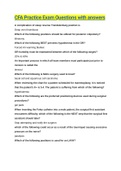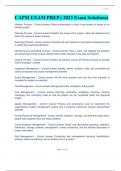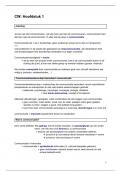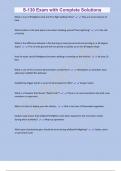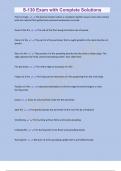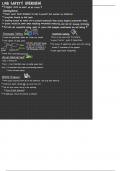Cash: Currency & coins, balances in checking accounts, items acceptable for deposit (checks & money orders)
- most liquid asset and the asset most easily stolen
Cash equivalents: money market funds, treasury bills, and commercial paper.
- investments must have a maturity date no longer than 3 months from the date of purchase
Internal Control: company’s plan to (a) encourage adherence to company policies and procedures
(b) promote operational efficiency
(c) minimize errors and theft
(d) enhance the reliability and accuracy of accounting data
*focus on controls intended to improve the accuracy & reliability of accounting information
*focus on safeguarding the company’s assets
The Sarbanes- Oxley Act requires a company to document and assess its internal controls. Auditors express an
opinion on management’s assessment (required by The Public Company Accounting Oversight Board AS 2201)
Committee of Sponsoring Organizations (COSO) defines internal control as a process, undertaken by an
entity’s board of directors, management and other personnel, designed to provide reasonable assurance
regarding the achievement of objectives in the following categories:
- Effectiveness and efficiency of operations
- Reliability of financial reporting
- Compliance with applicable laws and regulations
Internal Control Procedures – Cash Receipts
Separation of duties: IC technique in which various functions are distributed amongst employees to provide
cross-checking that encourages accuracy and discourage fraud
- Individuals that have physical responsibility for assets should not also have access to accounting
records (employees who handle cash should not be involved in the reconciliation of cash book balances to bank)
1. Employee A opens the mail each day and prepares a multi-copy listing of all checks including the amount and
payer’s name
2. Employee B takes the checks, along with one copy of the listing, to the person responsible for depositing the
checks in the company’s bank account
3. A second copy of the check listing is sent to the accounting department, where Employee C enters receipts
into the accounting records
(Because the person opening the mail is not the person who maintains the accounting records, it’s impossible for
one person to steal checks and alter accounting records to cover up their theft)
Internal Control Procedures – Cash Disbursements
- Proper controls for cash disbursement should be designed to prevent any unauthorized payments and ensure
that disbursements are recorded in the proper accounts
1. All disbursements, other than very small disbursements from petty cash, should be made by check. This
provides a permanent record for all disbursements
2. All expenditures should be authorized before a check is prepared. i.e. a vendor invoice for the purchase of
inventory should be compared with the purchase order and receiving report to ensure the accuracy of quantity,
price, part numbers, etc. This process should include verification of the proper ledger accounts to be debited
3. Checks should be signed only by authorized individuals
*An important part of any system of IC of cash is the PERIODIC RECONCILIATION of book balances and
bank balances to the correct balance
, Chapter 7: Cash and Receivables
Restricted Cash and Compensating balances
Current assets vs. Noncurrent assets (investments and funds or other assets)
- Restrictions on cash can be informal, arising from management’s intent to use a certain amount of $$ on
specific purposes. (i.e. company may set aside funds for future plant expansion)
- Restrictions are sometimes contractually imposed. (debt instruments often require borrower to set aside funds
(sinking funds) for the future payment of a debt)
- If the liability is current, the restricted cash also is classified as current
Compensating balance: specified balance (usually some % of the committee amount) a borrower of a loan is
asked to maintain in a low- interest or noninterest- bearing account at the bank)
- effect: higher effective interest rate on the debt
- compensate the bank for granting the loan or extending the line of credit
i.e. Suppose that a company borrows $10,000,000 from a bank at an interest rate of 12%. If the bank requires a
compensating balance of $2,000,000 to be held in a noninterest- bearing checking account, the company really
is borrowing only $8,000,000 (loan less the compensating balance)
- This means an effective interest rate of 15% - (1,200,000 interest / $8,000,000 cash available for use)
- A material compensating balance must be disclosed regardless of the classification of the cash
- IF CB arrangement is informal with no contractual agreement that restricts the use of cash, CB can be reported
as part of cash and cash equivalents, with note disclosure of the arrangement
i.e. LaDonia Company has 2 cash accounts with the following balances as of Dec 31,2018
- Under GAAP- 12/31/18 b/s would report cash asset of $300,000,
overdraft current liability of $15,000
- Under IFRS, LaDonia would report a cash asset of $285,000
Receivables: company’s claims to the future collection of cash, other assets, or services.
Account Receivables: AKA trade receivables results from sale of g/s on account
Non-trade receivable: interest receivable, loans, tax refund claims etc
**One company’s account receivable will be the mirror image of another company’s account payable
- Revenue and related AR are recognized at the point of delivery or service
- AR are current assets b/c they will be converted to cash within the normal operating cycle
- AR are INFORMAL credit arrangements supported by an invoice and are normally due in 30-60 days after
Initial Valuation of Accounts Receivable
- AR are typically not shown at present value
- Sellers can ignore financing component when it is not significant (when AR is due in <1 year
- Sellers usually record relatively short term account receivables at the entire amount the seller expects to
receive, rather than at the present value of that amount
- For long term AR, the financing component is more significant and sellers have to account for it
Discounts
Trade discount vs. cash discounts
Trade discounts: allows customers to pay an amount that is below the list price
I.e. manufacturer might list a machine part at $2,500 but sell it to an important customer at a 10%
discount. That discount of $250 is reflected by recording the sale at the agreed upon price of $2,250
- not a variable consideration, allows company to disguise real prices from competitors
Cash discounts: reduce the amount to be paid if payment occurs within a specified short period of time


